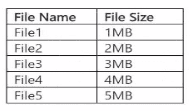Microsoft Developing Solutions for Microsoft Azure AZ-204 Exam Practice Test
You need to migrate on-premises shipping data to Azure.
What should you use?
Answer : D
Migrate from on-premises or cloud implementations of MongoDB to Azure Cosmos DB with minimal downtime by using Azure Database Migration Service. Perform resilient migrations of MongoDB data at scale and with high reliability.
Scenario: Data migration from on-premises to Azure must minimize costs and downtime.
The application uses MongoDB JSON document storage database for all container and transport information.
https://azure.microsoft.com/en-us/updates/mongodb-to-azure-cosmos-db-online-and-offline-migrations-are-now-available/
You create an Azure Cosmos DB for NoSQL database.
You plan to use the Azure Cosmos DB .NET SDK v3 API for NoSQL to upload the following files:

You receive the following error message when uploading the files: "413 Entity too large". You need to determine which files you can upload to the Azure Cosmos DB for NoSQL database. Which files can you upload?
Answer : B
Your company purchases an Azure subscription and plans to migrate several on-premises virtual machines to Azure. You need to design the infrastructure required (or the Azure virtual machines solution. What should you include in the design?
Answer : C
SIMULATION
You are developing a web application by using the Azure SDK. The web application accesses data m a zone-redundant BlockBlobStorage storage account
The application must determine whether the data has changed since the application last reao the data. Update operations must use the latest data changes when writing data to the storages..................
You need to implement the update operations.
Which values should you use? To answer, select the appropriate option m the answer area.
NOTE Each correct selection is worth one point.
Answer : A
See the answer in below image.

You develop and deploy an Azure App Service web app. The app is deployed to multiple regions and uses Azure Traffic Manager. Application Insights is enabled for the app.
You need to analyze app uptime for each month.
Which two solutions win achieve the goal? Each correct answer presents a complete solution
NOTE: Each correct selection is worth one point
Answer : A, C
https://azure.microsoft.com/en-us/blog/creating-a-web-test-alert-programmatically-with-application-insights/
Note: This question is part of a series of questions that present the same scenario. Each question in the series contains a unique solution. Determine whether the solution meets the stated goals.
You are developing and deploying several ASP.Net web applications to Azure App Service. You plan to save session state information and HTML output. You must use a storage mechanism with the following requirements:
*Share session state across all ASP.NET web applications
*Support controlled, concurrent access to the same session state data for multiple readers and a single writer
*Save full HTTP responses for concurrent requests
You need to store the information.
Proposed Solution: Add the web applications to Docker containers. Deploy the containers. Deploy the containers to Azure Kubernetes Service (AKS).
Does the solution meet the goal?
Answer : B
Instead use Azure Cache for Redis.
Note: Azure Cache for Redis provides a session state provider that you can use to store your session state in-memory with Azure Cache for Redis instead of a SQL Server database. To use the caching session state provider, first configure your cache, and then configure your ASP.NET application for cache using the Azure Cache for Redis Session State NuGet package.
https://docs.microsoft.com/en-us/azure/azure-cache-for-redis/cache-aspnet-session-state-provider
You are developing an Azure Function that calls external APIs by providing an access token for the API. The access token is stored in a secret named token in an Azure Key Vault named mykeyvault.
You need to ensure the Azure Function can access to the token. Which value should you store in the Azure Function App configuration?
A.

B.

C.

D.

Answer : D